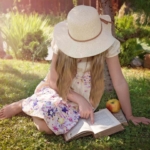
14 Apr There are 7 types of teen reader. What type is your teen?
A ‘Fiction Fanatic’ or a ‘Book Abstainer’?
Researchers Leonie Rutherford, Andrew Singleton, Bronwyn Reddan, Katya Johanson and Michael Dezuanni delve deeper and look how a parent can help.
We know teenagers have busy and complex lives. School makes increasing demands on them, as do their social and extracurricular activities. We also know video games, social media and TV and movies are very popular when they have down time.
So where do books come into this picture? Our new research looks at how much Australian teenagers are reading for leisure, and how we can help them read more.
Our study looked mainly at book reading
We surveyed more than 13,000 Australian high school students about their reading habits in their free time, away from school and homework. The survey was done between March 2022 and June 2023.
At first, we specifically looked at book reading. These could be fiction, non-fiction or graphic novels. It also included printed books or e-books.
Our survey showed showed 15% of students read daily, while 10% read four to six times a week. About 16% read two to three times a week and 12% once a week. However, a concerning 17% engage in reading less than once a week. The rest – 29% – don’t read at all.
This last figure is broadly similar to our smaller 2016 survey which found 29% don’t read on a weekly basis and 21% don’t read any books in a month.
We also looked at other kinds of reading, such as blogs, magazines, comics, news media and other articles. Most of those surveyed read these materials weekly or less, with only 10% reading these daily. More than one-third don’t engage with these materials at all in their free time.
Audiobooks were not popular either, with only 13% listening to audiobooks in their free time.

Cottonbro Studio/ Pexels, CC BY
Why is it so important to read books?
This lack of engagement with reading and books is a problem because reading for pleasure is associated with better school results as well as post-school job opportunities and emotional wellbeing.
This is because it improves vocabulary and builds contextual knowledge relevant to study. Reading also improves empathy through exposure to different ideas and perspectives.
Research also shows it is important to read longer books as opposed to shorter items such as emails or blog posts because sustained reading builds literacy for school success.
The 7 types of teen reader
Our research, which also included 118 interviews with publishers and booksellers, English teachers and librarians, and 20 focus groups with teenagers, identified seven types of teen readers from our survey results.
1. Fiction Fanatics: feel very positive about reading and read daily with a strong preference for fiction, and they read even more during holidays. They make up 12% of teen readers.
2. Regular Bookworms: also feel very positive about reading and read multiple times per week. They lean towards fiction but also read news and online articles. They make up 10% of teen readers.
3. Rushed Fans: also feel positive about about reading but read only 2-6 times a week during the school term. They read more during the holidays. They also prefer fiction but also read news articles and other articles online. They make up 9% of teen readers.
4. Casual Dabblers: read only 1-3 times per week, they feel less positive about reading and read the same or less during holidays. They make up 16% of teen readers.
5. Holiday Browsers: read infrequently and feel more neutral about reading. They are more likely to read more during holidays, usually fiction. They make up 10% of teen readers.
6. Sparse Readers: have neutral to negative feelings about reading. They tend to read articles on a weekly basis and books (mostly fiction) more rarely. They make up 10% of teens.
7. Book Abstainers: don’t engage with books or short-form reading. They make up 33% of teens (this figure is different from the 29% figure of non-readers in our survey. The survey results excluded responses from teenagers who did not finish the survey).

Becca Tapert/ Unsplash, CC BY
How can you help the teen in your life to read more?
What do these categories mean for parents and teachers who want to help the teens in their life to read more?
Our previous research has found the main reason teens give for not reading more is the difficulty of finding a good book.
While Fiction Fanatics have an excellent idea of what they like, teens who read less often lack familiarity with the types of fiction available. So they may need help identifying the genres, themes or formats they might enjoy. Talking to a librarian who knows about young adult literature such as a trained teacher-librarian or visits to a bookstore fronted by a passionate bookseller can broaden teens’ experience of what’s out there.
Adults can also help by having a selection of potential reads available to teens, particularly during holidays.
We found time time pressure is a significant barrier, even though occasional readers such as Rushed Fans and Holiday Browsers do return to reading when they have more free time. You can help ease time pressure by using holiday time to maximise reading.
Think about making an inviting space for reading at home (a comfortable couch will do) and setting up a time for communal reading at home. This will provide social support for your teenager to read. 
Leonie Rutherford, Associate professor, Deakin University; Andrew Singleton, Professor of Sociology and Social Research, Deakin University; Bronwyn Reddan, Research Fellow, Deakin University; Katya Johanson, Professor of Audience Research, Edith Cowan University, and Michael Dezuanni, Professor, Queensland University of Technology
This article is republished from The Conversation under a Creative Commons license. Read the original article.







